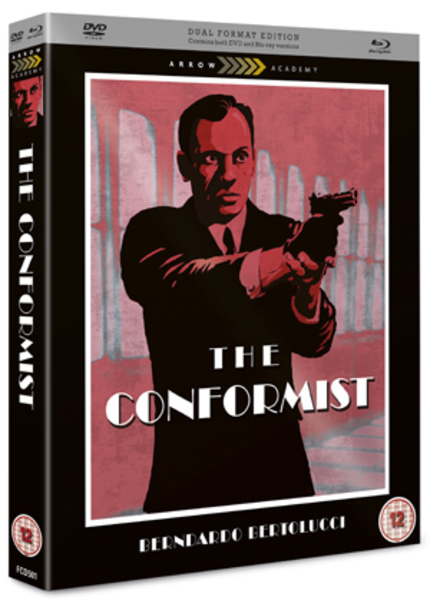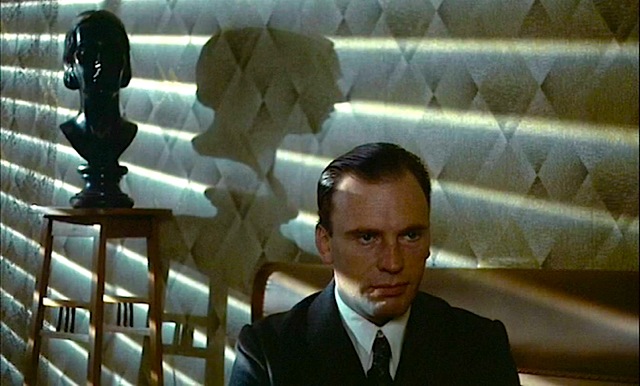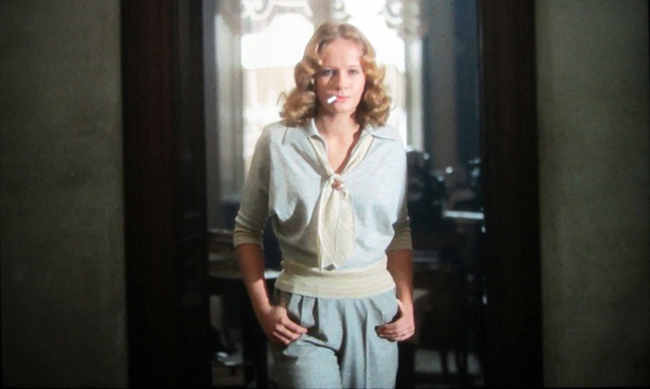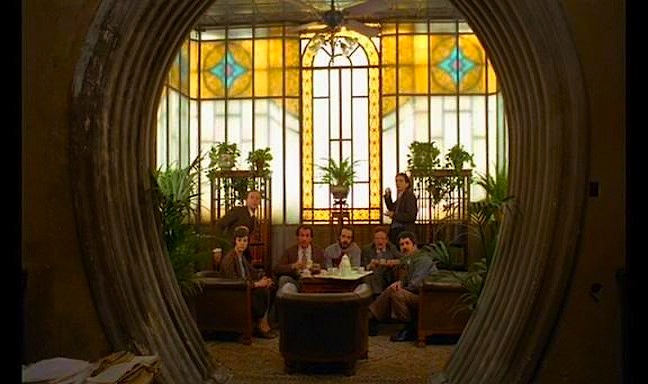Guest Blu-ray Review: THE CONFORMIST By Shade Rupe

One of the remarkable statements of a great film is its ability to have its title be intrinsic to its tale. In the case Bernard Bertolucci's of The Conformist, which is told with anything but conformity, the film is seen as a dominant expression of the mechanics of fascism, a tale of self-imposed sexual persecution, and an exploration of social psychology, though for the majority of its audience it's a glorious evocation of all that is cinema. Bernardo Bertolucci's The Conformist is rightly referred to as "a real filmmaker's film" by screenwriter and director Paul Schrader: "Bernardo wrote the bible, and we all just page through it." A film told through music, direction, performance, set and costume design, and most of all, style.
French actor Jean-Louis Trintignant's character of Marcello Clerici is bathed in red as the title credits fall upon him lying in bed ready to answer a telephone in whispered response. The neon sign outside flashes red, then off, a switching of light and dark that will occur throughout the film, as the entirety of his world is one of change, one of other faces, yet he desperately does everything he can to keep himself in line in an ever-evolving nonstop personal conundrum of motion. Clerici follows all orders: to spy on his former professor, Quadri, to his fiancée telling him that he must give confession if they are to be married. When he does protest it is small, and he quivers in the face of dominance.
Clerici's fate is predetermined by his personality. His inherent drive is to be normal, at all costs. Even his journey to save Anna culminates in his cold self-absorbed acceptance of fate and circumstance. His path is illustrated by his thoughts, the connective tissue the car ride to hell. As Clerici leaves his apartment building, an aura of stringed high vibrato sounds as we approach the entrance and he walks out from the red of his room to the blue of night (one of the many actual existing locations, this one seen in Orson Welles' The Trial) and steps into the car that will take him, and us, on the journey of his life, and his doom.
The layered elliptical nature of Bertolucci's adaptation of Albert Moravia's novel sends the viewer into paroxysms of visual delight. As the car pulls towards its predetermined destination, Clerici's thoughts drift to his visit to a radio studio while he views three women singing through a widescreen window framed in black and brightly lit within, and the camera itself moves forward into this frame within a frame. The entire film is told through windows, lights, and reflections. As Clerici's memory rebuilds and relates the film's story, we meet his bride-to-be Guilia (Stefania Sandrelli) at her mother's home in undulating light patterns emitting through Venetian blinds, drawing moving lines across Clerici and Guilia's embrace. Later we meet his morphine-addicted mother, and his 'friend' and foe, Manganiello played by the versatile Gastone Moschin, who would also grace Francis Ford Coppola's The Godfather: Part II in the role of Fanucci. In fact, Coppola was so entranced with Bertolucci's living, breathing cinema he referred to the look of the film when composing his shots for The Godfather: Part II, and would later have The Conformist's cinematographer Vittorio Storaro lens his epic Apocalypse Now. Storaro also commanded the photography of Dario Argento's The Bird with the Crystal Plumage.
 The meeting of each new character is adorned with yet another way of demonstrating their arrival in the film and Clerici's life. A most stunning entrance is that of Professor Quadri's wife, Anna. First seen seated, she re-enters the sitting room with a powerful face-front strut that rivals entrances performed by Dietrich and Garbo. Magnificently fleshed by the extraordinary actress Dominique Sanda in only her second film, and unbelievably at the very young age of eighteen (you will have to rub your eyes several times to believe this woman is only eighteen), lovers of the film most often cite Ms. Sanda as second to Mr. Storaro's cinematography, and maybe even parallel to Bertolucci's own gifts donated to this astonishing marvel of filmmaking.
The meeting of each new character is adorned with yet another way of demonstrating their arrival in the film and Clerici's life. A most stunning entrance is that of Professor Quadri's wife, Anna. First seen seated, she re-enters the sitting room with a powerful face-front strut that rivals entrances performed by Dietrich and Garbo. Magnificently fleshed by the extraordinary actress Dominique Sanda in only her second film, and unbelievably at the very young age of eighteen (you will have to rub your eyes several times to believe this woman is only eighteen), lovers of the film most often cite Ms. Sanda as second to Mr. Storaro's cinematography, and maybe even parallel to Bertolucci's own gifts donated to this astonishing marvel of filmmaking.
As Clerici and Manganiello move closer in their automobile to their unclaimable goal of halting the attack on Professor Quadri and Anna, Clerici's past is further revealed in layer upon layer of memory. He drifts off into reminiscence on his giving confession in order to marry Guilia, and while he orates to the priest he relates memory inside memory, reliving the experience of an young man a few years older than himself approaching him sensually and picking up the man's gun and ending his life. Although absolved in full by the subversive-hating holy father when he admits he's a Fascist, his guilt at destroying another man, his need to hide his guilt, his need to conform, to fit in, to belong, does not receive the same grace, and this drive for normalhood is what propels Clerici. He does nothing to remove himself from his self-destruction, just blindly accepting each new directive as the only path he can follow.
The Conformist is a very easy film to write about. Every new review, new article, and the propulsive wordsmithing of film writer Michael Atkinson's essay contribution to the 32-page booklet provided for Arrow Academy for this edition, displays how global the film's reception is. Each pair of eyes connected to a brain-stem sees something different in the picture. A tale of fascism, a tale of homosexual repression, a tale of bisexual female intrigue, a tale of voyeurism, and much more, is interpreted by its viewers. The magic of this film is embedded in its telling. When Clerici watches Anna seduce his more pedestrian partner, he hides in the shadows of a slightly open door, his presence fully known to his accomplice in deceit. While she caresses the other woman's leg she looks into the hallway's darkness, performing a show for her mysterious gentleman. There is nothing condemning in these actions as the characters live their lives of secrets and spies, of acceptance, and most of all, denial. The Conformist is one of those rare films that is universally regarded as a masterpiece across the ages. More than four decades after its first release we now enter the age of Blu-ray and can marvel at Vittorio Storaro's camerawork, Ferdinando Scarfiotti's breathtaking production design, Gitt Magrini's deft costumes, and Bertolucci's deft mise-en-scène, all sumptuously enveloped in Georges Delerue's lovely, evocative score for the film. A unique cinema experience now brought to the world in the best possible way at this time.

The Disc:
I'm almost happy enough to finally have a Blu-ray edition of The Conformist to dismiss some of the image discrepancies, though for a film of its stature one would hope for a tighter control of the image. The film is here, it probably looks better than it has in arthouses in many years, though in spring 2010, at the opening of the new theaters at Lincoln Center, Paul Schrader introduced a new digital presentation of the film which was much stronger and sharper. That screening delivered Ms. Sanda's hallway walk as if she were a Bengal tiger, planting each muscled paw in steady rhythm before the audience. Here she looks great, but you wish the remote came with a 'sharpen' button. That said, the colors are spectacular; the shifts from red, to blue, to yellow, to orange, the now-restored 'blind ballroom' scene with its colorful balls of party lights delivers a swoon-worthy image, and it's (somewhat) easy to forget the soft transfer with the wash of images delivered by maestros Bertolucci and Storaro.
In fact I so enjoy this release that I watched it three times through the evening it arrived in my mailbox. I watched once with subtitles, once with commentary, and once with just images and the Italian language, to fall into its dreaminess. It is a definite upgrade from Paramount's R1 2006 disc, though there is definite room for improvement for a Stateside reissue from the studio.
A very worthwhile additional feature in the 'Kiosk' section of the disc is the extremely erudite and strategically crafted commentary by film expert David Forgacs. The wealth of information he provides is worthy of a physical book publication. I've actually watched the film with his commentary on twice now and took notes both times. The smallest details are seen as large as the sun by his microscopic and heavily researched examination of the film, drawing upon singular interviews in magazines published in 1971, television interviews, and much more. Forgacs reveals that Clerici's target, his former professor Quadri, shares the same real-life phone number and address of Bertolucci's former mentor Jean-Luc Godard, as one of many enlightenments of the film's construction.
A 51-minute-long documentary, Bernardo Bertolucci: Reflections on Cinema, featuring film clips over the length of Bertolucci's career, with on-set archive material and interviews directed by Sandro Lai, appears on the Blu-ray disc only. A fine compilation of choice sentences from the world-class director, flipping in and out of time as he's younger, older, middle-aged, bearded, and not; a smart way to present an overview of the man's philosophies and notes on the evolving art of cinema.
The aforementioned booklet contains Michael Atkinson's essay, an interview with Bertolucci from the spring 1971 issue of Sight & Sound, a pastiche of Bertolucci quotes culled from the book Film Forum: Thirty-Five Top Directors Discuss Their Craft, and some still reproductions. An interesting addition is three foreign posters of the film from the Czech Republic, Poland, and France, that can be used in place of Arrow's choice for the front cover. Arrow Academy's presentation of The Conformist is a Region B Blu-ray so you must have a region-free Blu-ray player to view the film. The release also comes with a PAL DVD.
The images contained in this column are compressed and do NOT reflect the image quality on the disc itself.

Do you feel this content is inappropriate or infringes upon your rights? Click here to report it, or see our DMCA policy.





